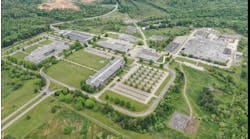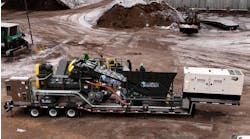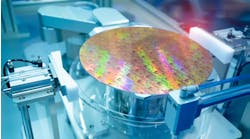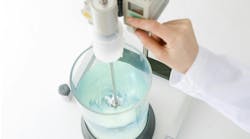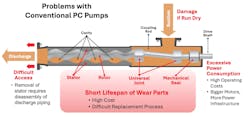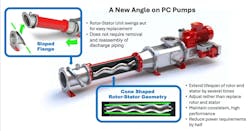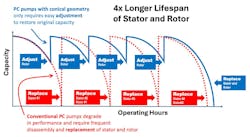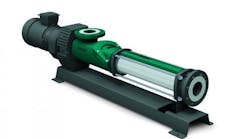A New Design for Progressive Cavity Pumps Removes Challenges for the Wastewater Industry
Traditionally, progressive cavity (PC) pumps have been regarded as the best solution for the most demanding fluid pumping challenges. They excel at handling highly viscous, abrasive, and debris-laden media, making them particularly effective in wastewater treatment facilities.
Despite these advantages, conventional PC pumps have gained a reputation for difficult and frequent maintenance, high lifecycle costs, and inefficient power consumption. Consequently, industry professionals sometimes opt for alternative solutions, even if it means sacrificing performance.
However, it's time to rethink this perspective. Advancements in the design of progressive cavity pumps have successfully addressed the problems associated with traditional PC pumps. These advancements have led to a significantly extended service life of wear parts—many times longer—while radically simplifying operations and maintenance.
Now, professionals can leverage all the benefits that make progressive cavity pumps ideal for demanding applications—without the traditional drawbacks. These innovations have established PC pumps as a better choice for engineers and operators who prioritize reliability, efficiency, cost-effectiveness, and ease of maintenance in the toughest wastewater fluid handling applications.
Let's explore the common complaints about conventional progressive cavity pumps and how innovative design improvements have successfully mitigated these issues.
Short Lifespan of Stator and Rotor
The short lifespan of wear parts is a significant issue for conventional progressive cavity pumps. The operating principle relies on continuous contact and compression between the rotor and stator. Abrasive media contributes to component wear, necessitating frequent, costly, and difficult replacements. Some manufacturers attempt to mitigate excessive wear by using exotic and expensive materials of construction or increasing the number of pressure stages, but this approach significantly increases the footprint of the pump as well as the price.
The stator and rotor can account for over 50% of a pump's original price. Maximizing their lifespan is crucial for a good return on investment and reducing the Total Cost of Ownership (TCO) and for maximizing performance and availability.
In conventional progressive cavity pumps, wear and tear inevitably create gaps between the rotor and stator, leading to a decrease in capacity. This typically results in a sudden and significant drop in pump performance, necessitating the replacement of the stator, and often, the rotor as well.
New Design Extends Stator and Rotor Lifespan 4x
The revolutionary, patented design of the Vogelsang HiCone has effectively solved the problem. Instead of replacing the rotor and stator after the erosion of the contact surfaces, Vogelsang HiCone allows operators to advance the cone-shaped rotor into the mated cone-shaped stator.
Regaining original pump performance can now be achieved with just a few turns of an adjustment nut using a standard wrench or through an automated system.
This adjustment provides renewed compression of the stator elastomer against the rotor, without changing the shape of the cavity. The resulting benefit is that the same flows and pressures are achieved equivalent to when the pump was new.
Past attempts to design an adjusting system required holding the stator elastomer in place with a temporary clamshell or metallic "slats." These multi-component designs pose risks, such as rupture and leakage. The escaping of pumped liquids can allow exposure to biohazards or dangerous chemicals. Furthermore, these old methods of compression adjustment were tedious to perform and tended to deform the cavities of the pump, leading to poor performance and unpredictable wear.
The revolutionary conical design eliminates the need for frequent, costly, and difficult part replacements and the associated downtime. The HiCone adjustment system can be fine-tuned to operating conditions like pressure and temperature, maximizing performance and prolonging service life many times over.
Compression between the rotor and stator can be regulated from the control room through the entire service life, allowing for predictive maintenance and planning. An integrated wear scale also indicates the current condition of the pump.
Difficult Process to Replace Parts
Compounding the problem of frequent and costly replacement of rotors and stators in traditional progressive cavity pumps is the difficulty of performing this procedure, an extremely time-consuming and labor-intensive process.
This design exposes the pumped liquid to the atmosphere, which can be problematic when dealing with sticky liquids or those that harden upon contact with air. Mechanical seals are designed to "weep," but this can lead to erosion from abrasive particles passing between the faces, and hazardous fluids may escape through this pathway. Moreover, the absence of lubrication during a run-dry condition frequently causes premature failure.
Advanced progressive cavity pumps protect the mechanical seals from these vulnerabilities by having a liquid barrier on the non-product side of the seal faces that can be pressurized. Moreover, the HiCone pump is designed to streamline the process of replacing the seal. A new, pre-assembled mechanical seal can be installed without disassembling the entire pump.
Excessive Power Consumption
Conventional progressive cavity pumps require significant horsepower for the torque needed to start the pump. Not only does this consume more electricity, but it also increases the pump's purchase cost, and the extensive power infrastructure required, including the motor, VFD, and electrical components, to supply sufficient power.
The unique conical geometry of the rotor and stator in the HiCone series, coupled with automated axial readjustment, offers multiple benefits. Apart from significantly extending the lifespan of the rotor and stator, it also results in substantial savings from lower power consumption and smaller system sizing—requiring much less horsepower to start the pump.
Whenever the operator stops the pump, HiCone pumps equipped with automated controls record the precise operating position of the rotor and then retract it. Upon restarting, the rotor begins to rotate with minimal clamping before moving the rotor back to the original operating position. As a result, the intelligent startup process requires much less horsepower than other progressive cavity pumps need for starting torque.
Risk of Damage When Run Dry
To overcome pressure in the discharge piping and prevent slip, progressive cavity pumps depend on a tight fit between the metal rotor and the elastomer stator. The rotor's outer diameter is intentionally slightly larger than the stator's inner diameter, causing compression of the stator.


